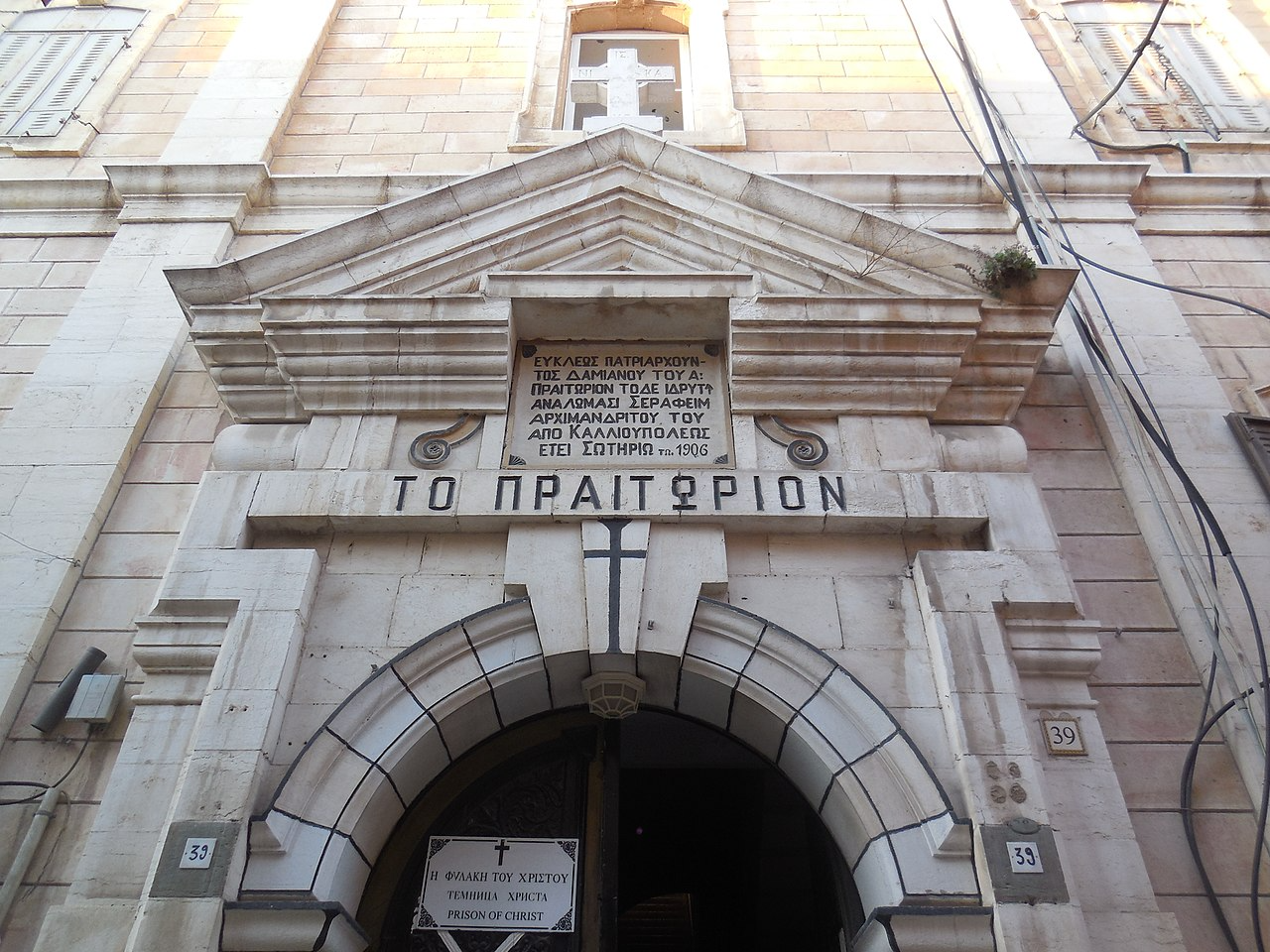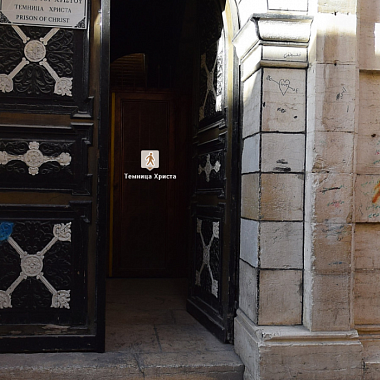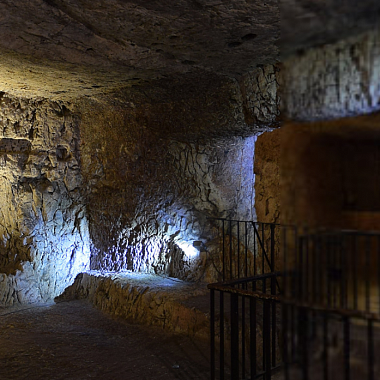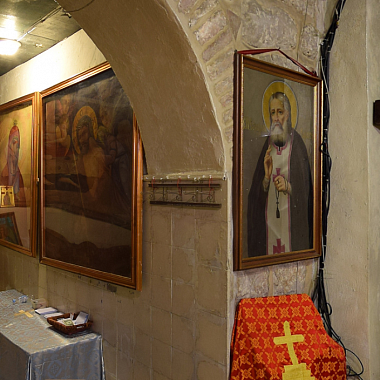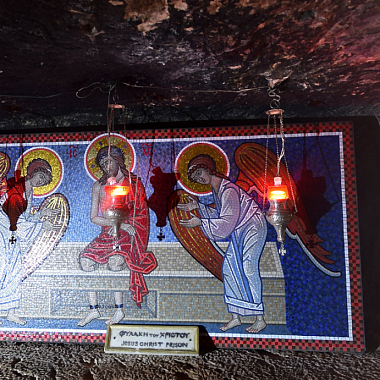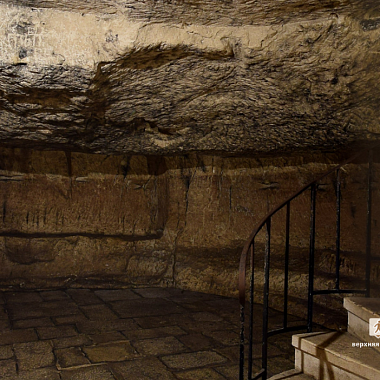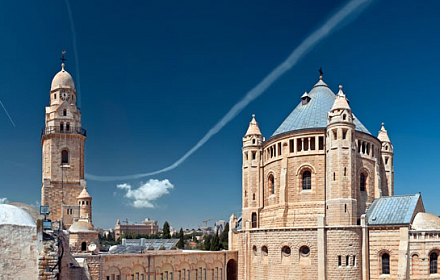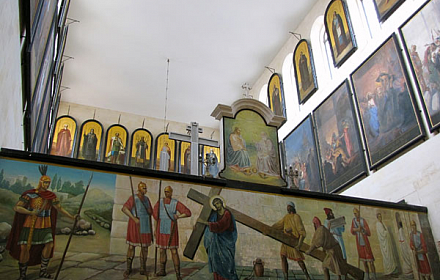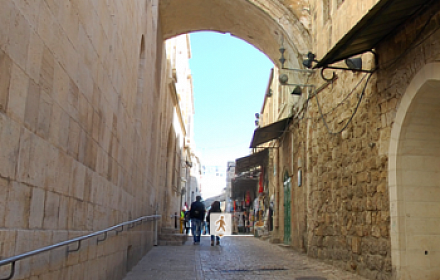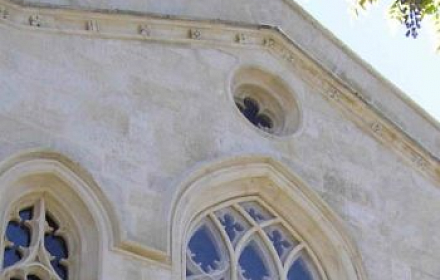About Virtual Tour
Entrance
Walking down the Via Dolorosa — the Way of the Cross, near the Convent of the Sister of Zion one can see a Greek Orthodox Church with the inscription above the entrance: “Prison of Christ”. According to tradition, it was built upon the site where Jesus Christ was confined before standing trial in Pilate’s court. A robber named Barabbas was also imprisoned in the same underground guardroom. Most probably, there were other criminals: for example, the robber who repented on his cross — and the second one who did not.The Orthodox pilgrims begin their procession along the Way of Sorrow with this small church, while western Christians start their route earlier — from the Franciscan church of the Flagellation. We’re going to talk about it another time, but now we go inside the small chapel known as the Prison of Christ, built above the Roman Praetorium’s jail. Let's go on a virtual pilgrimage.
Prison
“They lead Jesus therefore from Caiaphas into the Praetorium” — this is what the Gospel of John says (18:28). Since 1911 the site with its caves has been claimed to be the real Prison of Christ by the Greek Orthodox Church. Above was built the chapel “Prison of Christ” with an inscription above the entrance, making it easy to find for pilgrims and tourists visiting Jerusalem for the first time.Ancient steps leads to the caves, which two thousand years ago were transformed into prison cells for temporary custody of the criminals; inside each of them there is a flat elevation. The main holy place is a niche in the wall with a stone bench. This is the place in which Christ was detained.
At the time the Praetorium’s basement where Our Lord was confined used to be the residence of the Roman governor Pontius Pilate. It was on the territory of the Antonia Fortress, built by Herod the Great to the north of the Temple Mount.
Church
Beneath the Prison of Christ there is a cave with stone benches and wall-fitted rings. According to tradition, it was used as a cell for the robber named Barabbas mentioned in the four gospels. The book “The Acts of Apostles” explains (3:14) that Barabbas was sentenced for a murder — the Holy Scriptures and the Holy Tradition of the Church do not give any specific information regarding his criminal activities.In any event, the Roman authorities considered the guilt of Barabbas as serious: he was arrested, tried and sentenced to death. Fortunately for the criminal, the day before the execution fell on the Jewish festival of Passover, when according to the local tradition, one of the convicted prisoners on death row could be liberated by popular acclaim, making a choice between the candidates offered by the Roman governor.
When Pontius Pilate offered the Jews to use their right and release one of the criminals, they preferred Barabbas instead of “Jesus Christ of Nazareth”. It is unknown whether the former subsequently entered on the path of correction.
It may be interesting to note that some ancient Greek manuscripts of the Gospel of Matthew have the full name of the robber Barabbas as “Jesus Barabbas”. Origen also noted that such spelling of the criminal’s name was quite common in his time. It is possible that the original full name of Barabbas was really so, but later it was shortened to avoid confusion with the name of Jesus Christ.
Prison of Christ
Under the arches of the Prison of Christ reigns a silent awe. The niche in the wall where Jesus Christ stayed has distinctive round holes, in which they put the feet of prisoners. We cannot know for certain whether the Romans considered it appropriate to use the same procedure for Christ, “obedient unto death”. Yet, Christ bound in chains became a frequent visual subject of religious art. One such icon stands above the bench, where the Savior was seated.The Prison of Christ is not be confused with another site on the north side of the Church of the Holy Sepulcher, which is called “the Chapel of Bonds”. While in the Praetorium’s jail the Savior stayed awaiting Pilate’s judgment, in a small cave near Calvary He waited until the cross is set up, being surrounded by Roman guards. In this place His feet were indeed put into stone stocks. At the cave’s entrance were standing Virgin Mary with holy myrrh-bearers — this is where Mary was said to watch Her Son being nailed to the cross…
These two close events happened in two different locations and are sometimes confused due to very similar icons. We will talk about the iconography later, after we come from the Prison of Christ into the church building.
Cave
The Greek church above the Prison of Christ offers many chairs for the convenience of its visitors. Apart from that, it has an ascetic interior, decorated only with big icons. Of course, some of them depict the Savior bound in chains in the final hours of His earthly life.It has already been said that there are many depictions of this holy picture both in Western and Eastern Christian traditions. “Midnight Savior”, “The Bridegroom”, “King of the Jews”, “Ecce Homo” and “Virum Dolorum” — all of them can be traced back to the foretype of an imprisoned and chained Jesus Christ. Some of them depict Him alone with bound hands and wearing a crown of thorns, while the others present Him seated with feet put in stone stocks and surrounded by angels prostrating before Him.
Unfortunately, the Greek church, which allows access into the prison that dates back to the 1st century AD — the one where Christ was confined — is not always open. If our short virtual tour gets you interested and once you find yourself in the Holy City and you see that these doors are open, do not hesitate to go inside. It’s well worth it! In the words of a well-known Jerusalem tour guide, here the two-thousand-year history is getting much closer.
Send donation
If you are in a difficult financial situation, we will light the candle for free. For that purpose email us at coordinator@santosepulcro.co.il
Payment Methods
